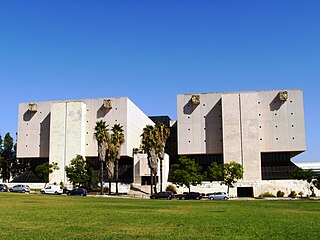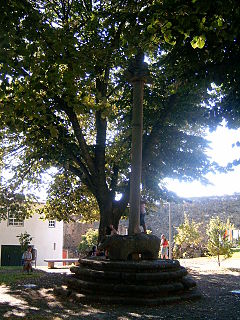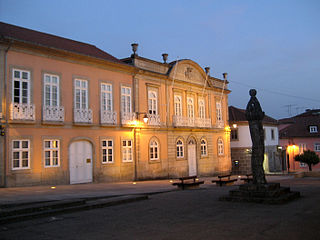
São José is a civil parish in the municipality of Ponta Delgada on the island of São Miguel in the Portuguese archipelago of the Azores. It is one of the constituent parts of the city of Ponta Delgada, and location of many of the island's more significant cultural and historical, commercial and residential buildings. Extending a short distance along the coast it, nevertheless includes a large mixed urban-rural constituency from the shore north to the main freeway, the Via-Rápida. The population in 2011 was 5,934, in an area of 1.66 km².

Povoação is a municipality located in the southeastern corner of the island of São Miguel in the Portuguese archipelago of the Azores. The population in 2011 was 6,327, in an area of 106.41 km².

Alandroal is a municipality in the Portuguese district of Évora located on the eastern frontier with Spain along the right margin of the Guadiana River in the Central Alentejo region. It is located 341 metres (1,119 ft) above sea level, northeast of Évora and southeast of Estremoz. The population in 2011 was 5,843, in an area of 542.68 km².

The Santa Justa Lift, also called Carmo Lift, is an elevator, or lift, in the civil parish of Santa Justa, in the historical city of Lisbon, Portugal. Situated at the end of Rua de Santa Justa, it connects the lower streets of the Baixa with the higher Largo do Carmo.

The National Archive of Torre do Tombo is the Portuguese national archive located in the civil parish of Alvalade, in the municipality of central-northern Lisbon. Established in 1378, it was renamed the Instituto dos Arquivos Nacionais in 2009.

Nelas is a municipality located in the Centro Region of continental Portugal. The population in 2011 was 14,037, in an area of 125.71 km².

Castle of Braga is a historical fortification and defensive line encircling the city of Braga. While, in fact, the only remains of this structure are the various gates and towers along its perimeter, the main keep tower, located in the civil parish of São João do Souto, is the only true remnant of the medieval castle.

The Casa dos Bicos is a historical house in the civil parish of Santa Maria Maior, in the Portuguese municipality of Lisbon. The house, built in the early 16th century in the Alfama neighbourhood, has a curious façade of spikes, influenced by Italian Renaissance palaces and Portuguese Manueline styles. It survived the disastrous 1755 Lisbon earthquake that destroyed much of the city, but over time was abandoned as a residence and used as a warehouse. After a 20th-century renovation, it became the headquarters of the José Saramago Foundation and a location of the Museum of Lisbon.

Frechas is a Portuguese civil parish, located in the municipality of Mirandela, in the district of Bragança. The population in 2011 was 929, in an area of 18.54 km².

The Bica Funicular, sometimes known as the Elevador da Bica, is a funicular railway line in the civil parish of Misericórdia, in the municipality of Lisbon, Portugal. It connects the Rua de São Paulo with Calçada do Combro/Rua do Loreto, operated by Carris. Although commonly described as a funicular, technically it does not qualify because the traction is not provided by a mechanical cable but by electric motors on the two cars. The cable links the two cars together so that they ascend and descend simultaneously, each car acting as a counterweight for the other one.

The Fountain of Colher, is a fountain in the civil parish of Miragaia, in the municipality of Porto, under the level of the Rua Nova da Alfândega.

Nossa Senhora do Bispo is a former civil parish in the municipality of Montemor-o-Novo, Portugal. In 2013, the parish merged into the new parish Nossa Senhora da Vila, Nossa Senhora do Bispo e Silveiras. It has an area of 121.83 km², and a population of approximately 5411 inhabitants in 2001. It contains the localities Fazendas do Cortiço, Ferro da Agulha and São Geraldo.

Castle of Loulé is a castle in the municipality of Loulé, in the Portuguese Algarve. Classified a National Monument, since 20 June 1924, three towers remain within the cordon of walls, the remnants of the alcaldaria located within the structure.
The Castle of Degebe is a medieval castle located in the civil parish of Reguengos de Monsaraz, in the municipality of Reguengos de Monsaraz, Portuguese district of Évora.

The Pillory of Bragança is a 15th-century sculpted stone column with symbolic political, administrative and judicial significance, erected over a four-step octagonal platform, located in the civil parish of Sé, Santa Maria e Meixedo, municipality of Bragança. It consists of a cylindrical column erected over a square platform, sculpted with zoomorphic symbols, anthropomorphic scenes and the shield of the city of Bragança. Its structural design and sculptural ornamentation is characteristics of the era; the column is classified as a National Monument since 1910.

The Pillory of Aguiar da Beira is a pillory located in the civil parish of Aguiar da Beira e Coruche, in the municipality of Aguiar da Beira, Portuguese district of Guarda.

The Pillory of Arcos de Valdevez is a 15th-century sculpted stone column with symbolic political, administrative and judicial significance, located in the civil parish of Arcos de Valdevez (Salvador), Vila Fonche e Parada, municipality of Arcos de Valdevez.

The Pillory of Braga is a 15th-century sculpted stone column with symbolic political, administrative and judicial significance, located in the civil parish of Maximinos, Sé e Cividade, municipality of Braga.

The Walls of Dom Fernando, or Fernandine Walls, are medieval fortifications located in the civil parish of Cedofeita, Santo Ildefonso, Sé, Miragaia, São Nicolau e Vitória, in the municipality of Porto, Portuguese Porto.
The Castro of Castelo Velho is a Chalcolithic settlement in the civil parish of Terena, municipality of Alandroal in the Alentejo Central area of the Portuguese Alentejo.
























